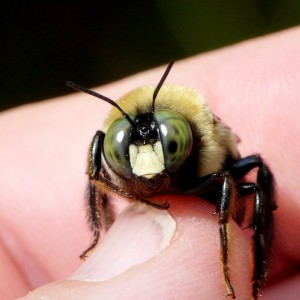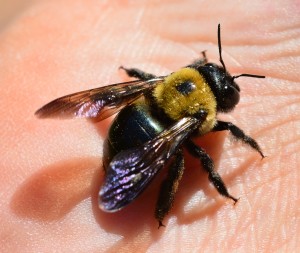When winged assailants — bees, wasps, biting flies — come after us, well, we evolved to run or swat. Now, running makes sense. But swatting?
Sometimes that swatting thing can be an evolutionary dead end. Swat the wrong wasp and next thing you know the entire nest is on your case. An injured (or annoyed) wasp releases “attack pheromones” that tell its kith and kin there’s danger afoot and they’d best do

something about it, fast. If we get in the door quickly enough, too often we run for the wasp spray — not, by the way, a recommended IPM practice except in the most desperate cases. There’s simpler, more timely tricks of the trade. We suggested a couple in our May 18 post.
Besides, not all creatures that buzz can harm us. That big bumble bee dive-bombing you — well, first off, it’s unlikely it’s a bumble bee. Bumble bees are remarkably gentle. But then, carpenter bees — bumble-bee lookalikes, only lots less furry — usually are too. (And remember: correct identification is key to good IPM.)

Right now female carpenter bees are (as the saying goes) busy as bees. Whether it’s a horizontal tree branch, a cut log, your porch railing or the eaves of your home, they’re making nests for their young. If you just happen to wander too close, you might end up face to face with a large (and agitated) black and yellow bee — a mate-guarding male.
But in reality there’s nothing to fear.
Why? Because male carpenter bees have no stinger and pose no threat. So why all the fuss? The males are protecting females as they sculpt out nesting sites. If you stand by long enough, you might see several bees buzzing and tumbling with each other. You can identify the males by the pale yellow patch on their face. Two patch-faced tumbling bees — those are males in a tussle. One patch-faced, one without — those bees are mating.

And the females? They have a stinger. But they sting only at need to protect their nest. See some perfectly round holes (about a half-inch across) in your railing? These entryways make a 90-degree bend where females start creating galleries that run with the grain.
What do they eat? Nectar — which makes them useful pollinators. But these bees are smart cookies. When it comes to garden flowers like salvia and penstemon — anything with a slender, tubular flower that these big bees can’t get into — they become nectar robbers. They simply cut a slit at the base of corolla and steal the nectar, presumably leaving the pollination to somebody else.
So next time you’re hazed by a male carpenter bee, just stand quietly by (“quietly” is the operative word) and enjoy the show as they tumble about, mating with flying females or buzzing competing males. Next thing you know, they’re ignoring you entirely.
How to prevent them tunneling into your railings and eaves? After all, left untreated for years, it’s not that good for a home’s structural integrity. Seek no further for IPM’s: Get Rid of Carpenter Bees? Yes Please!
Many thanks to IPMer Matt Frye for providing the original material. Photo credits: male carpenter bee from duggiehoo.deviantart.com/art/. Female carpenter bee from ysmad.com, Wikimedia Commons. Nesting galleries: buzzaboutbees.net/carpenter-bees.html.